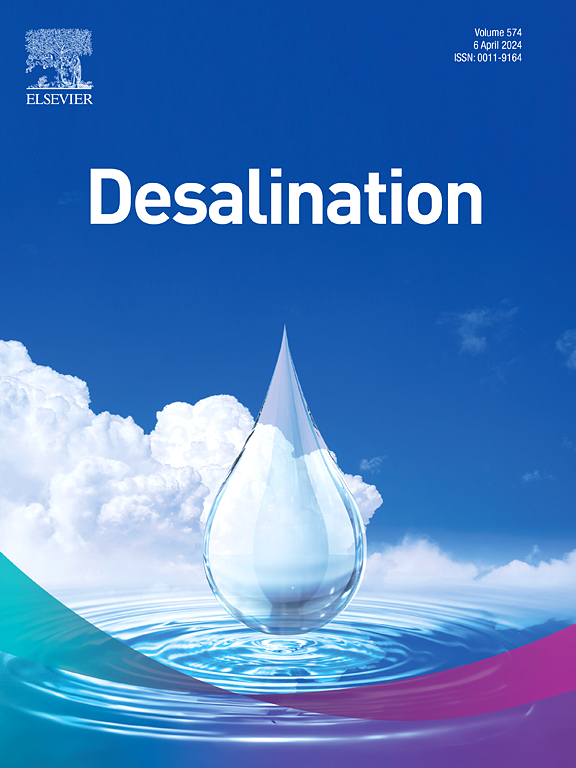Chemical free pH control for efficient lithium recovery via redox-couple mediated bipolar membrane electrodialysis
IF 9.8
1区 工程技术
Q1 ENGINEERING, CHEMICAL
引用次数: 0
Abstract
A novel redox couple mediated bipolar membrane electrodialysis (redox-BMED) system was developed and optimized to enable chemical free pH control for lithium precipitation. Unlike conventional methods that rely on alkaline reagents such as NaOH, this system utilizes in situ water dissociation through a bipolar membrane (BPM) and reversible redox mediation (Fe(CN)64−/Fe(CN)63−), thereby avoiding additional chemical inputs for pH control. The effects of operating conditions such as applied voltage (0.6–1.2 V), flow rates (2–10 mL/min) and electrodes stacking were investigated. Maximum performance was achieved with a lithium ion flux of 13.82 g-Li+/m2d and energy consumption of 1.33 Wh/g. A techno-economic analysis was conducted to evaluate the cost-effectiveness of the redox-BMED system compared to conventional BMED. The redox-BMED system demonstrated over 70 % reduction in total annual cost, primarily due to simplified stacking design and lower membrane usage. Overall, these findings indicate that redox-BMED offers a viable alternative for lithium recovery in CO2 based precipitation processes. Its ability to combine chemical free pH control, high purity product formation, and competitive economic returns underscores its potential for large-scale lithium recycling and resource utilization.

通过氧化还原偶联介导的双极膜电渗析控制有效锂回收的无化学pH值
开发并优化了一种新型氧化还原偶联介导的双极膜电渗析(redox- bmed)系统,以实现锂沉淀的无化学pH控制。与依赖碱性试剂(如NaOH)的传统方法不同,该系统通过双极膜(BPM)和可逆氧化还原介质(Fe(CN)64−/Fe(CN)63−)利用原位水解耦,从而避免了额外的化学输入来控制pH。研究了施加电压(0.6 ~ 1.2 V)、流速(2 ~ 10 mL/min)和电极堆叠等操作条件对电极的影响。锂离子通量为13.82 g- li +/m2d,能耗为1.33 Wh/g时,电池性能达到最高。进行了技术经济分析,以评估氧化还原-BMED系统与常规BMED系统相比的成本效益。氧化还原- bmed系统的年总成本降低了70%以上,这主要归功于简化的堆积设计和更低的膜使用量。总的来说,这些发现表明,氧化还原- bmed为CO2基沉淀过程中的锂回收提供了一种可行的替代方案。它结合了无化学pH控制、高纯度产品形成和有竞争力的经济回报的能力,强调了其大规模锂回收和资源利用的潜力。
本文章由计算机程序翻译,如有差异,请以英文原文为准。
求助全文
约1分钟内获得全文
求助全文
来源期刊

Desalination
工程技术-工程:化工
CiteScore
14.60
自引率
20.20%
发文量
619
审稿时长
41 days
期刊介绍:
Desalination is a scholarly journal that focuses on the field of desalination materials, processes, and associated technologies. It encompasses a wide range of disciplines and aims to publish exceptional papers in this area.
The journal invites submissions that explicitly revolve around water desalting and its applications to various sources such as seawater, groundwater, and wastewater. It particularly encourages research on diverse desalination methods including thermal, membrane, sorption, and hybrid processes.
By providing a platform for innovative studies, Desalination aims to advance the understanding and development of desalination technologies, promoting sustainable solutions for water scarcity challenges.
 求助内容:
求助内容: 应助结果提醒方式:
应助结果提醒方式:


